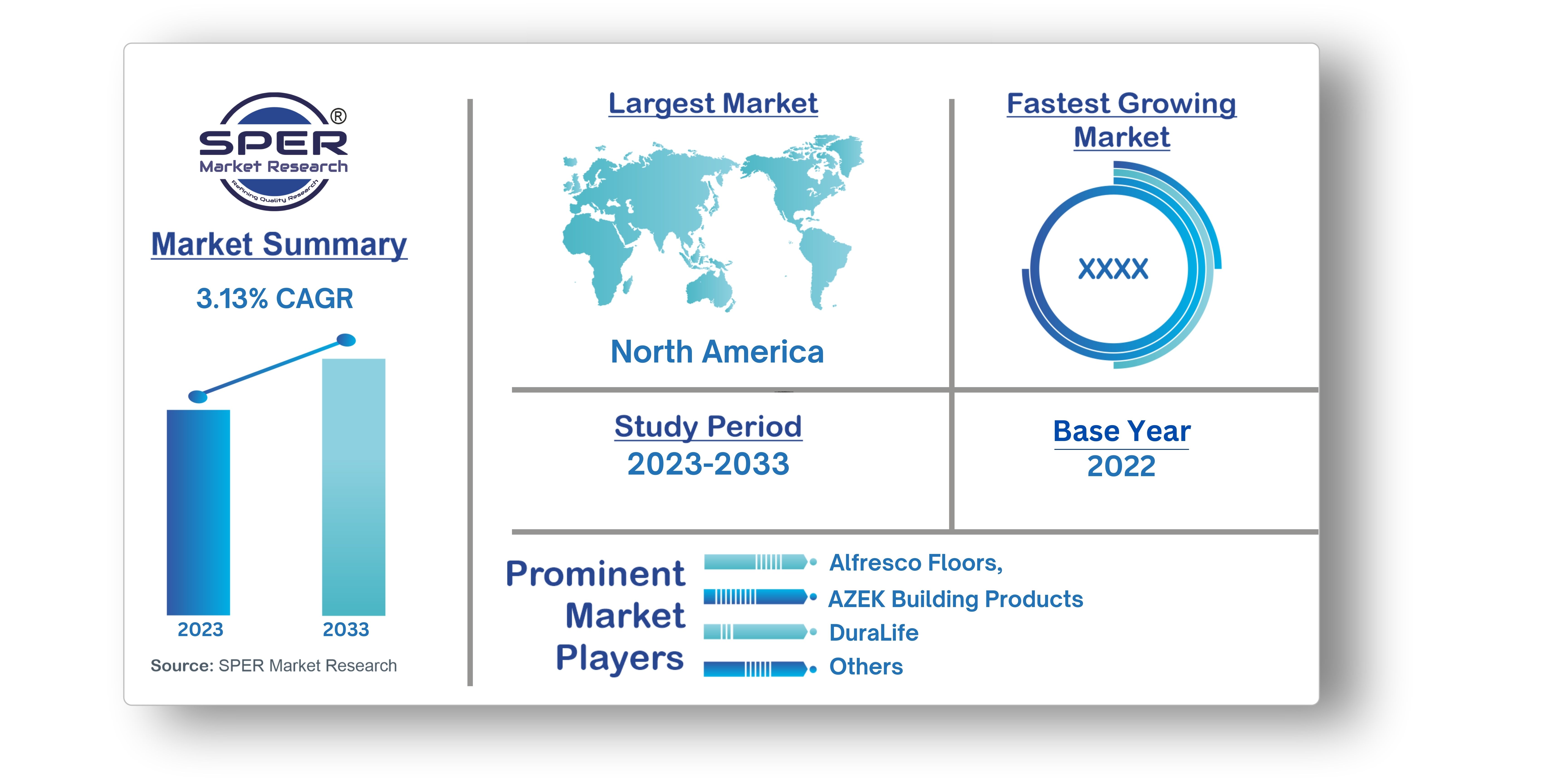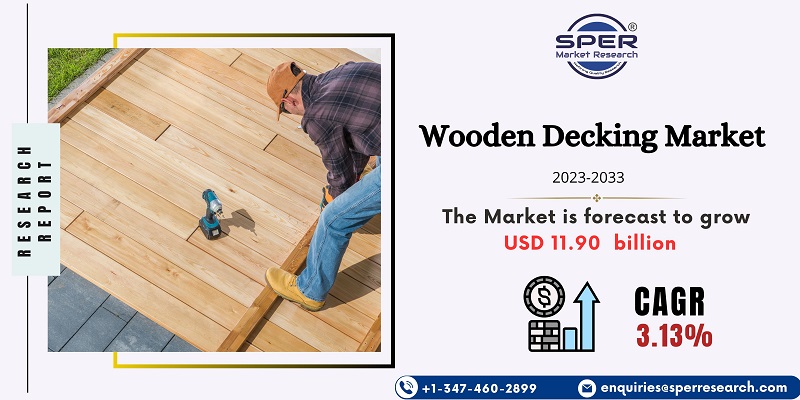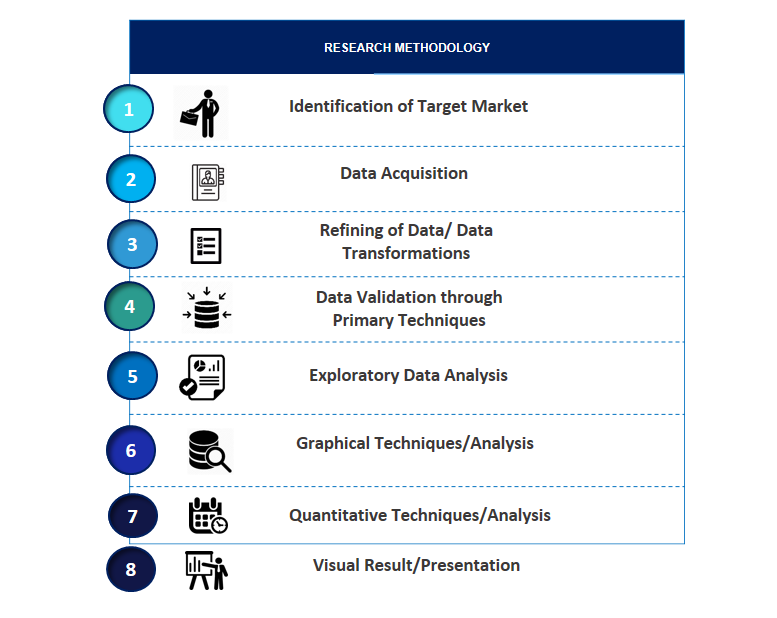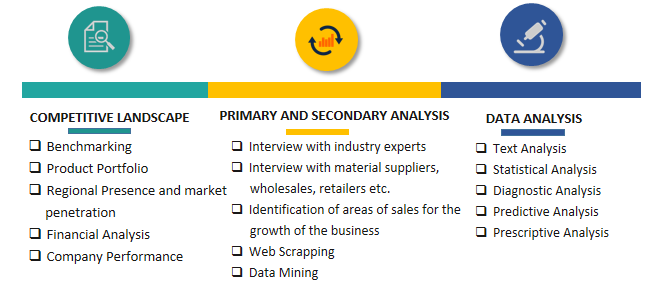
Wooden Decking Market Growth, Size, Trends, Revenue, Demand, Challenges and Future Outlook
Wooden Decking Market Size- By Product Type, By Application, By Type of Construction, By End User- Regional Outlook, Competitive Strategies and Segment Forecast to 2033
| Published: Nov-2023 | Report ID: COAM2345 | Pages: 1 - 224 | Formats*: |
| Category : Construction & Manufacturing | |||
- October 2022: AZEK Company Inc. opened its first production facility in Boise, Idaho, the Western United States. The 350,000-square-foot state-of-the-art facility further advances AZEK's strategy to promote material conversion to its types of long-lasting, low-maintenance, and environmentally sustainable outdoor living products. It also allows the company to scale to meet market demand for its goods.
- July 2023: To expand the reach of its innovative composite decking line, Oldcastle APG's well-known brand MoistureShield® and Mid-Am Building Supply, Inc. forged a strategic alliance.


| Report Metric | Details |
| Market size available for years | 2019-2033 |
| Base year considered | 2022 |
| Forecast period | 2023-2033 |
| Segments covered | By Product Type, By Application, By Type of Construction, By End-User |
| Regions covered | North America, Asia-Pacific, Latin America, Middle East & Africa and Europe |
| Companies Covered | Alfresco Floors, AZEK Building Products, DuraLife, Fiberon, Kebony, Metsa Wood Thermory AS, , UFP Industries, Vetedy Group, West Fraser Timber Co. Ltd., and others. |
- Wooden decking manufacturers
- Raw material producers and suppliers
- Wooden decking distributors and traders
- End-use sectors
| By Product Type: |
|
| By Application: |
|
| By Type of Construction: |
|
| By End-User: |
|
- Global Wooden Decking Market Size (FY’2023-FY’2033)
- Overview of Global Wooden Decking Market
- Segmentation of Global Wooden Decking Market By Product Type (Cedar, Pressure treated wood, Redwood , Tropical hardwood, Tigerwood, Mahogany, Teak, Ipe, others)
- Segmentation of Global Wooden Decking Market By Application (New decks on existing constructions, New decks on new constructions, Repairs & re-modelling)
- Segmentation of Global Wooden Decking Market By Type of Construction (Addressable, Conventional)
- Segmentation of Global Wooden Decking Market By End-User (Non-Residential, Residential)
- Statistical Snap of Global Wooden Decking Market
- Expansion Analysis of Global Wooden Decking Market
- Problems and Obstacles in Global Wooden Decking Market
- Competitive Landscape in the Global Wooden Decking Market
- Impact of COVID-19 and Demonetization on Global Wooden Decking Market
- Details on Current Investment in Global Wooden Decking Market
- Competitive Analysis of Global Wooden Decking Market
- Prominent Players in the Global Wooden Decking Market
- SWOT Analysis of Global Wooden Decking Market
- Fire Alarm and Detection Market Future Outlook and Projections (FY’2023-FY’2033)
- Recommendations from Analyst
- Government and R&D institutions
- Market research and consulting firms
- Associations and industry bodies
1.1. Scope of the report1.2. Market segment analysis
2.1. Research data source
2.1.1. Secondary Data2.1.2. Primary Data2.1.3. SPER’s internal database2.1.4. Premium insight from KOL’s
2.2. Market size estimation
2.2.1. Top-down and Bottom-up approach
2.3. Data triangulation
4.1. Driver, Restraint, Opportunity and Challenges analysis
4.1.1. Drivers4.1.2. Restraints4.1.3. Opportunities4.1.4. Challenges
4.2. COVID-19 Impacts of the Global Wooden Decking Market
5.1. SWOT Analysis
5.1.1. Strengths5.1.2. Weaknesses5.1.3. Opportunities5.1.4. Threats
5.2. PESTEL Analysis
5.2.1. Political Landscape5.2.2. Economic Landscape5.2.3. Social Landscape5.2.4. Technological Landscape5.2.5. Environmental Landscape5.2.6. Legal Landscape
5.3. PORTER’s Five Forces
5.3.1. Bargaining power of suppliers5.3.2. Bargaining power of buyers5.3.3. Threat of Substitute5.3.4. Threat of new entrant5.3.5. Competitive rivalry
5.4. Heat Map Analysis
6.1. Global Wooden decking market Manufacturing Base Distribution, Sales Area, Product Type6.2. Mergers & Acquisitions, Partnerships, Product Launch, and Collaboration in Global Wooden Decking Market
7.1. Global Wooden decking market Value Share and Forecast, By Product Type, 2023-20337.2. Cedar7.3. Ipe7.4. Mahogany7.5. Pressure treated wood7.6. Redwood7.7. Teak7.8. Tigerwood7.9. Tropical hardwood7.10. Others
8.1. Global Wooden decking market Value Share and Forecast, By Application, 2023-20338.2. Building materials8.3. Rails & infrastructure
9.1. Global Wooden decking market Value Share and Forecast, By Type of Construction, 2023-20339.2. New decks on existing constructions9.3. New decks on new constructions9.4. Repairs & re-modelling
10.1. Global Wooden Decking Market Value Share and Forecast, By End-User, 2023-203310.2. Non-Residential10.3. Residential
11.1. Global Wooden Decking Market Size and Market Share
12.1. Global Wooden Decking Market Size and Market Share By Product Type (2019-2026)12.2. Global Wooden Decking Market Size and Market Share By Product Type (2027-2033)
13.1. Global Wooden Decking Market Size and Market Share By Application (2019-2026)13.2. Global Wooden Decking Market Size and Market Share By Application (2027-2033)
14.1. Global Wooden Decking Market Size and Market Share By Type of Construction (2019-2026)14.2. Global Wooden Decking Market Size and Market Share By Type of Construction (2027-2033)
15.1. Global Wooden decking Market Size and Market Share By End-User (2019-2026)15.2. Global Wooden decking Market Size and Market Share By End-User (2027-2033)
16.1. Global Wooden decking Market Size and Market Share By Region (2019-2026)16.2. Global Wooden decking Market Size and Market Share By Region (2027-2033)
16.3. Asia-Pacific
16.3.1. Australia16.3.2. China16.3.3. India16.3.4. Japan16.3.5. South Korea16.3.6. Rest of Asia-Pacific
16.4. Europe
16.4.1. France16.4.2. Germany16.4.3. Italy16.4.4. Spain16.4.5. United Kingdom16.4.6. Rest of Europe
16.5. Middle East and Africa
16.5.1. Kingdom of Saudi Arabia16.5.2. United Arab Emirates16.5.3. Rest of Middle East & Africa
16.6. North America
16.6.1. Canada16.6.2. Mexico16.6.3. United States
16.7. Latin America
16.7.1. Argentina16.7.2. Brazil16.7.3. Rest of Latin America
17.1. Alfresco Floors
17.1.1. Company details17.1.2. Financial outlook17.1.3. Product summary17.1.4. Recent developments
17.2. AZEK Building Products
17.2.1. Company details17.2.2. Financial outlook17.2.3. Product summary17.2.4. Recent developments
17.3. DuraLife
17.3.1. Company details17.3.2. Financial outlook17.3.3. Product summary17.3.4. Recent developments
17.4. Fiberon
17.4.1. Company details17.4.2. Financial outlook17.4.3. Product summary17.4.4. Recent developments
17.5. Kebony
17.5.1. Company details
17.5.2. Financial outlook17.5.3. Product summary17.5.4. Recent developments
17.6. Metsa Wood
17.6.1. Company details
17.6.2. Financial outlook17.6.3. Product summary17.6.4. Recent developments
17.7. Universal Forest Products
17.7.1. Company details
17.7.2. Financial outlook17.7.3. Product summary17.7.4. Recent developments
17.8. Thermory AS
17.8.1. Company details
17.8.2. Financial outlook17.8.3. Product summary17.8.4. Recent developments
17.9. Vetedy Group
17.9.1. Company details17.9.2. Financial outlook17.9.3. Product summary17.9.4. Recent developments
17.10. Others
SPER Market Research’s methodology uses great emphasis on primary research to ensure that the market intelligence insights are up to date, reliable and accurate. Primary interviews are done with players involved in each phase of a supply chain to analyze the market forecasting. The secondary research method is used to help you fully understand how the future markets and the spending patterns look likes.
The report is based on in-depth qualitative and quantitative analysis of the Product Market. The quantitative analysis involves the application of various projection and sampling techniques. The qualitative analysis involves primary interviews, surveys, and vendor briefings. The data gathered as a result of these processes are validated through experts opinion. Our research methodology entails an ideal mixture of primary and secondary initiatives.



Frequently Asked Questions About This Report
PLACE AN ORDER
Year End Discount
Sample Report
Pre-Purchase Inquiry
NEED CUSTOMIZATION?
Request CustomizationCALL OR EMAIL US
100% Secure Payment






Related Reports
Our Global Clients
Our data-driven insights have influenced the strategy of 200+ reputed companies across the globe.




















